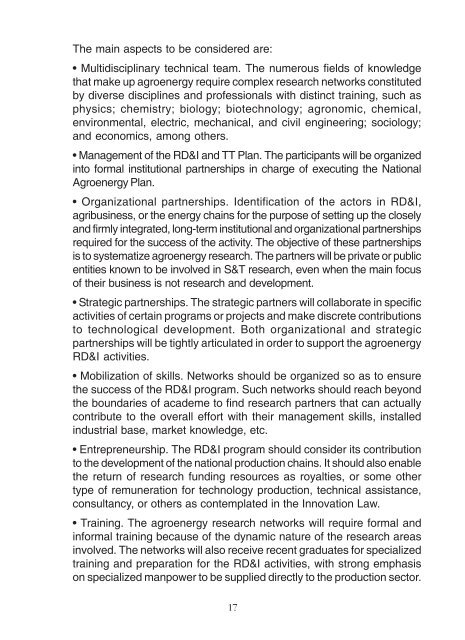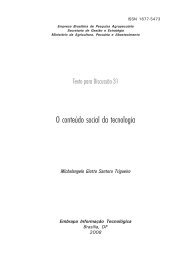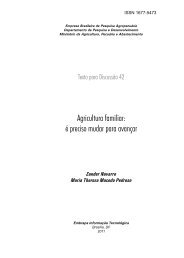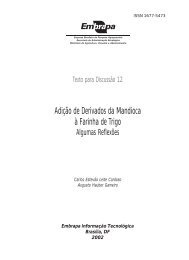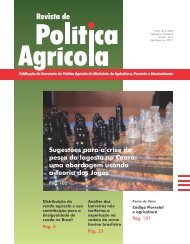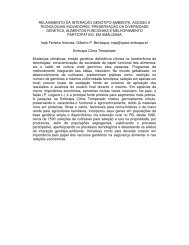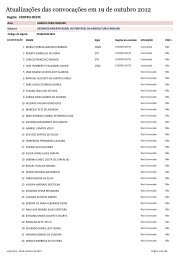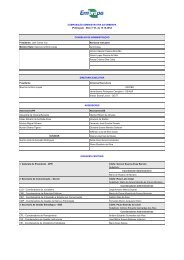Ministry of Agriculture, Livestock and Food Supply - Embrapa
Ministry of Agriculture, Livestock and Food Supply - Embrapa
Ministry of Agriculture, Livestock and Food Supply - Embrapa
You also want an ePaper? Increase the reach of your titles
YUMPU automatically turns print PDFs into web optimized ePapers that Google loves.
The main aspects to be considered are:<br />
• Multidisciplinary technical team. The numerous fields <strong>of</strong> knowledge<br />
that make up agroenergy require complex research networks constituted<br />
by diverse disciplines <strong>and</strong> pr<strong>of</strong>essionals with distinct training, such as<br />
physics; chemistry; biology; biotechnology; agronomic, chemical,<br />
environmental, electric, mechanical, <strong>and</strong> civil engineering; sociology;<br />
<strong>and</strong> economics, among others.<br />
• Management <strong>of</strong> the RD&I <strong>and</strong> TT Plan. The participants will be organized<br />
into formal institutional partnerships in charge <strong>of</strong> executing the National<br />
Agroenergy Plan.<br />
• Organizational partnerships. Identification <strong>of</strong> the actors in RD&I,<br />
agribusiness, or the energy chains for the purpose <strong>of</strong> setting up the closely<br />
<strong>and</strong> firmly integrated, long-term institutional <strong>and</strong> organizational partnerships<br />
required for the success <strong>of</strong> the activity. The objective <strong>of</strong> these partnerships<br />
is to systematize agroenergy research. The partners will be private or public<br />
entities known to be involved in S&T research, even when the main focus<br />
<strong>of</strong> their business is not research <strong>and</strong> development.<br />
• Strategic partnerships. The strategic partners will collaborate in specific<br />
activities <strong>of</strong> certain programs or projects <strong>and</strong> make discrete contributions<br />
to technological development. Both organizational <strong>and</strong> strategic<br />
partnerships will be tightly articulated in order to support the agroenergy<br />
RD&I activities.<br />
• Mobilization <strong>of</strong> skills. Networks should be organized so as to ensure<br />
the success <strong>of</strong> the RD&I program. Such networks should reach beyond<br />
the boundaries <strong>of</strong> academe to find research partners that can actually<br />
contribute to the overall effort with their management skills, installed<br />
industrial base, market knowledge, etc.<br />
• Entrepreneurship. The RD&I program should consider its contribution<br />
to the development <strong>of</strong> the national production chains. It should also enable<br />
the return <strong>of</strong> research funding resources as royalties, or some other<br />
type <strong>of</strong> remuneration for technology production, technical assistance,<br />
consultancy, or others as contemplated in the Innovation Law.<br />
• Training. The agroenergy research networks will require formal <strong>and</strong><br />
informal training because <strong>of</strong> the dynamic nature <strong>of</strong> the research areas<br />
involved. The networks will also receive recent graduates for specialized<br />
training <strong>and</strong> preparation for the RD&I activities, with strong emphasis<br />
on specialized manpower to be supplied directly to the production sector.<br />
17


